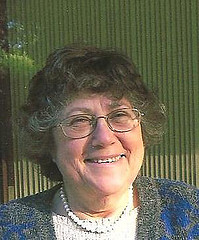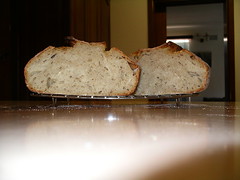
Pumpernickel bread try nbr. 2
Hi everybody
That it's! now that I know how to pin my photos I can try and write my own blog ! after one year on TFL it was about time. My thanks to Ananda who helped me to sort the problem photo uploading.
Until now I was baking rye bread using the method of no knead/dutch oven bake. My recipe was based on approx. 200 gr. Rye SD, 400gr water and 600gr bread flour, and salt. Sometime I would subsitute 50 or 100gr of bread flour for Rye flour to make the Rye flavour stronger. Once I mixed 75gr. of Zäthar (mix of thyme, olive oil, sesame seeds and other herbs imported from Jordan or Lebanon) the bread turned green and I didn't really enjoy the flavour result..Although I like Zäthar very much with pitas or sour white cheese named Labané in arabic, humus etc...
I'm limited with the bread I can bake as my oven is not working properly and burn every thing on the back side, which mean that I gave up trying to bake baguettes, bâtards or any bread on the open. No white bread allowed as my partner has diabete. Our diet is very strict about what is good for him ( which after all is also good for me..) and the bad stuff is out. Not that we lost weight with all the bread we are eating!
Lately we began to buy Pumpernickel made after a Dutch recipe, it's almost black and sliced very thin, it's wet and pretty sweet... A piece or two without anything on it and you feel full enough to go from breakfast to lunch. This pumpernickel reminded me that in my younger years we were buying Jewish Pumpernickel bread in Paris and it was not at all the same. I looked at TFL under pumpernickel and found the recipe by Greenstein reviewed by Dsnyder. After I resolved the problem to find cracked rye which was not very easy since the last 2 years the crops of rye had been very small in Australia, but I got Rye in grains or berries and I crushed the quantity I needed in the coffe grinder : the only one of my grinders that doing it.I ground it very shortly just to crack it and some grains stayed uncrushed. I then put this in water and leaved it for the night. The next day I took the extra water off and after about 15 minutes of draining I weighted the rye to know how much water it had taken in (thanks again Ananda for the tips)and could adjust the water I needed to add.
This is a second try, with the quantities indicated by Dsnyder, but instead of caramel powder I put 3 tablespoons of molasses which made the bread dark, but a bit too sweet for my liking. The bread is moist and very good. Next time I will reduce the molasses to 2 tablespoons or use barley malted extract which is not so sweet. I didn't spread any cornflour on the top to make tha glaze David did on his bread.Not feeling well I baked it in a bread machine, but next time I will bake it in the oven, in a tin, or in my closed cast iron pot.
The photos have been taken with flash and no flash : it's why the color of the bread is different, the real one is the dark. I even took one outside on the veranda trying the natural light..
The big difference in tast is that a normal rye is much more acidic than the pumpernickel and I liked this acidity, but the pumpernickel is really tasty..


with a bit of early sun on it... no sun no flash = the real color

the crumb from short distance - you can feel the cracked rye when you eat the bread but it's soft and nice. you don't brake a tooth on it !


A rye bread baked few weeks ago and its crumb, the color is not too bad even with the flash on.
Wow, the editing of this first blog was a long journey for me! Bea


Comments
Bee, I took your advice on making rye using no knead instead of Greenstein's methods. I have done it a few times and it has come out the best ryes I've been able to make. But I think the key was reducing the rye flour percentage. It seems to be a lot harder to make these high percentage ryes come out well. And yours look beautiful! Varda
thanks Varda for your comment and I'm happy that your baking turn to better. At least I'm not the only one to profess this method regarding the Rye bread making.
I also found that reducing the rye flour in the mix with the bread flour would give better results, but then it's not as healthy as you wish. Lately you can see a lot of new posts about baking with a higher purcentage of Rye. I didn't try as I was on my way to do the pumpernickel. I might try one of those recipes. I had in the past very poor result with higher purcentage of Rye but I never put any of my baking in the bin !
here is one of my flop... although tasty and crispy but didn't spring in the baking which can be the SD or too much Rye or not enough water... I learned slowly to adjust and to keep as precise as possible the purcetage of every ingredients.
Bea
Hi Bea,
These look wonderful loaves. I think of the 2nd loaf as a Pain Siegle; is that how you would describe it? A wheat loaf, but leavened with a rye sourdough?
I've posted just now on a 75% Rye from a Hamelman recipe; you can see it here: http://www.thefreshloaf.com/node/17539/slight-variations-two-more-formulae-hamelman039s-quotbreadquot
I'm really glad you got the photo uploading sorted out.
Best wishes
Andy